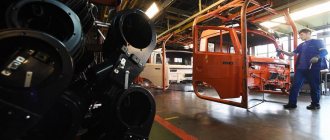April 26, 2021 Lada.Online 11 392 17
The Lada Vesta, XRAY, Granta, Kalina and Priora cars use several types of transmissions, including gearboxes with the indices VAZ 2180, VAZ 2181 and VAZ 2182. Since June 22, 2016, AVTOVAZ has introduced a gear profile in the manufacture of these front-wheel drive gearboxes f. VICURA. We tell you why this was done.
VAZ 2180 what kind of car is this?
The new model from AVTOVAZ, called LADA Vesta, has already acquired its own history. Initially, the new model was known as LADA V. Later, AVTOVAZ assigned the new product its own index: VAZ-2180 or LADA 2180. At the initial design stage, the model was prepared to replace the Lada Priora family. For a long time this model appeared on the Internet as LADA Priora 2 (Lada Priora 2). Now the car has its own name - LADA Vesta.
At the beginning of 2014, Bo Inge Andersson became the president of AVTOVAZ. After his arrival, the AVTOVAZ development program was revised. At the same time, changes were made to the development of the LADA brand model range. In particular, it became known from the program that AVTOVAZ plans to produce the LADA Vesta in two body types: sedan and hatchback. In the second half of 2015, the Lada Vesta sedan should appear on the assembly line, and the LADA Vesta hatchback should appear in 2016.
The design of LADA Vesta is being developed under the leadership of the British Steve Mattin, who gained fame as a designer at the German Daimler and the Swedish Volvo. Back in the fall of 2012, he demonstrated his vision of future LADA models in the X-RAY concept car. The first production car to inherit the features of the concept will be Vesta.
The LADA Vesta is based on the LADA B platform, which is almost entirely a domestic development. This platform has incorporated the results of several projects: elements of the French-Japanese B0 platform (Largus, Logan, Almera), the unrealized “LADA C project”, developments on the LADA Priora.
It is assumed that Vesta will be equipped with a 1.8 liter engine, which was developed as part of “Project C”. Also, a 1.4-liter supercharged power unit producing 150 hp may appear in the engine range. power and 240 Nm of torque. VAZ is developing this motor together with Ricardo. It is also possible that the range of engines will be replenished with a 1.6-liter, 16-valve unit producing 117 hp. from Renault Fluence.
According to reports, the Lada Vesta will receive a modern manual gearbox with a cable-driven shift mechanism. There are no plans to install the automatic on the LADA Vesta yet - instead of it, Vesta can get the one currently being developed together with.
Vesta will have a completely original suspension with L-shaped arms, a 5-degree caster and new steering knuckles. It will be mounted on a subframe. The Lada Vesta will receive steering and rear suspension from Renault Megane.
The price of LADA Vesta was initially announced at around 400 thousand rubles. In May 2014, Bo Andersson in an interview reduced the cost of the car, saying that the price of the Lada Vesta will start from 350-400 thousand rubles.
It is expected that the LADA Vesta will be presented to the public at the Moscow International Motor Show 2014, which will be held in August. The start of serial production of LADA Vesta is scheduled for September 2015.
Source
How much does Lada Priora weigh?
The weight of the car before restyling in 2013 was as follows:
- The 3-door hatchback coupe, 5-door hatchback and sedan have a curb weight (which includes the weight of a full tank of fuel and the driver) of 1088 kg. In this case, the total weight (i.e., the maximum permissible weight of the vehicle at which it can be operated after being fully loaded) is 1578 kg;
- The station wagon, with the same curb weight, is able to take a little more cargo, and its total weight reaches 1593 kg.
Thus, the station wagon is the most load-carrying of all Priora body types.
Lada Vesta
To replace Priora. History and tuning of Lada Vesta
Story
In 2015, the first batch of sedans rolled off the assembly line, and in 2016 it was planned to begin production of hatchbacks, but subsequently the manufacturer refocused on the production of a universal and off-road version of Vesta. AvtoVAZ took this step to avoid intra-brand competition with the XRAY model.
Engines with 106 and 122 horsepower paired with a robotic gearbox are installed under the hood of the model. In 2016, a batch of Vests were also released, equipped with 110-horsepower engines from Nissan. The steering is also imported, taken from Renault Megane. The brakes and radiator are borrowed from joint developments between Renault-Nissan and, judging by customer reviews, this was a good move on AvtoVAZ’s part.
The maximum Vesta configuration includes side airbags. AvtoVAZ produced a limited series of Lada Vesta with dual-fuel engines running on both gas and gasoline. In addition, an electric version of Vesta with a power of 60 kW was presented. However, the manufacturer does not disclose whether serial production is planned and when sales can begin.
Interesting Facts
Tuning for Lada Vesta
To protect your car from dirt, winter road agents and summer insects, it will be useful to install a frame with a “PROSPORT” mesh to protect the radiator.
Cosmetic tuning includes the installation of thresholds (the manufacturer left the necessary holes on the sides in advance) or linings around the perimeter of the car. It would be useful to work on the interior lighting system, interior and exterior of the Lada Vesta. Install sports seats, reupholster the interior in leather, add car audio and a multimedia system - there are many solutions to make trips on Vesta more comfortable and enjoyable.
One of the interesting and inexpensive proposals for external design can be called special contrasting stickers on the body, emphasizing the “X-like” appearance of the relief.
If you want to eliminate factory defects or completely “customize” your Lada Vesta, contact the Tuning Sport specialists. Sign up for the tuning of your dreams right now!
Consult and sign up for tuning by phone: +7(903) 124 78 25, (Monday to Friday from 11-00 to 20-00, Moscow)
Source
Specifications
Below we will talk about each element of the Lada Priora separately, namely, we will consider separately the body, engine, trunk, etc.
Body
Priora was produced in several bodies. In 2007, only a sedan appeared; later, in 2008, the first hatchback and station wagon rolled off the assembly line.
Sedan 2170
This body turned out to be very nice and most popular among young people. Young people started buying Priora and subjecting it to various tunings. It became a kind of youth movement.
Station wagon 2171
This type of body is an excellent solution for family people. The station wagon is equipped with a huge trunk.
Hatchback 2172
The hatchback does not differ from the sedan in technical characteristics and the front part of the body, but is shorter by several centimeters, which is noticeable to the naked eye.
Engine
Several types of engines with different power and number of valves were installed on the Lada. The table below shows all installed engines and their characteristics.
| Model | 21126 | 21127 | 21116 |
| Number of valves | 16 | 16 | 8 |
| Power (hp) | 98 | 106 | 87 |
| Type | Petrol | Petrol | Petrol |
| Torque, Nm / rpm | 145/4000 | 148/4200 | 140/3800 |
| Number of cylinders | 4 | 4 | 4 |
| Cylinder arrangement | Row | Row | Row |
| Volume (cubic cm) | 1596 | 1596 | 1596 |
| Fuel | Gasoline AI 95 | Gasoline AI 95 | Gasoline AI 95 |
| Power type | Electronic injection | Electronic injection | Electronic injection |
| Maximum speed, km/h | 183 | 183 | 172 |
| Acceleration time to 100 km/h | 11,5 | 11,0 | 12,5 |
| Average fuel consumption per 100 km | 7,2 | 7,2 | 7,6 |
Gear box
Priora was equipped with several gearboxes depending on the configuration and year of manufacture of the car. All gearboxes are 5-speed
Gearbox with rocker
This gearbox was installed on cars from 2007 to 2013. It is a fairly reliable and unpretentious gearbox, its main “soreness” is the weak second gear, which begins to fly out over time.
Cable gearbox
Installed on cars since 2014. Received a large number of positive reviews, the position of the gears, namely the reverse gear, has changed. The vibrations transmitted to the cabin from the gearbox have been reduced.
Robotic gearbox
In 2014, luxury car models began to be equipped with a robotic gearbox. It is very reliable and unpretentious, but noticeably loses in dynamics compared to a manual transmission.
Other characteristics
| Characteristic | Sedan | Station wagon | Hatchback |
| Height, mm | 1420 | 1435 | 1508 |
| Width, mm | 1680 | 1680 | 1680 |
| Length, mm | 4350 | 4340 | 4210 |
| Wheelbase, mm | 2492 | 2492 | 2492 |
| Weight, kg | 1163 | 1163 | 1088 |
| Number of seats | 5 | 5 | 5 |
| Number of doors | 5 | 5 | 5 |
| Drive unit | front | front | front |
| Wheels | 185/65 R14 | 185/65 R14 | 185/65 R14 |
| Tank capacity, l | 43 | 43 | 43 |
| Trunk volume, l | 430 | 444/777 (with rear seats folded) | 360/705 (with rear seats folded) |
Lada Vesta. Who does she look like?
Vesta is the name of the goddess. In ancient Rome, this was the name of the deity responsible for the family hearth and other marital values. We do not rule out that it was the word “marriage” that AvtoVAZ management liked so much that “Vesta” will be the name of the new model of the Lada brand. What does Roman mythology have to do with it, you ask? We don't know the answer.
The plant officially announced that the word Vesta should be associated among buyers not only with the hearth, but also with comfort, and with spring, and with renewal. The latter is perhaps most appropriate. The fact is that it is with the Lada Vesta that the long-awaited global update of the AvtoVAZ model range should begin, because the whole model family, into which Vesta will subsequently grow, is being developed on the new Tolyatti platform. It is now known as Lada B, and perhaps nothing more is known about it.
It's funny, but the first car built on this secret platform was seen by almost all Russians who don't shy away from following thematic news. The sensational Lada XRay crossover concept, the first example of the Tolyatti period in the work of the famous designer Steve Mattin, is based on it. More precisely, on its prototype, which, meanwhile, was already capable of moving independently at the stage of construction of the concept.
However, then it was assumed that the platform would debut in the series with the new generation of Lada Priora, but AvtoVAZ chose to give the Priora a light restyling. Last one before discontinuation. Obviously, it is “Vesta” that will take the place of the famous family in the AvtoVAZ lineup. It will also become the first production car of the Lada brand, whose design will be made in a new corporate style, precisely specified by the XRay concept.
According to the standards of ancient Roman mythology, the goddess Vesta was depicted with a covered face. The appearance of the future new product is also officially considered a mystery, despite the fact that the plant’s conveyor belt is already actively preparing for the start of production. But the ubiquitous industrial spies have already managed to leak the first design sketches onto the Internet, according to which the Lada Vesta will indeed borrow a lot from the Lada XRay - in particular, the harsh stampings on the sides and the X-shaped solution of the “face” of the car. Everyone can draw their own conclusion about the aesthetic value of the new Lada. However, it seems to us that the simple transfer of stylistic solutions from a conceptual crossover to a small production sedan did not add any appeal to it. Nice try, AvtoVAZ, but...
Spy photographs of the “live” prototype, leaked, oddly enough, to the Russian press from Western publications, only confirm the authenticity of the sketches “leaked” not so long ago. Both here and there the same stampings are clearly visible, the characteristic outlines of the radiator grille and the like are visible. So it’s quite possible to say that the Lada Vesta has “revealed its face” and to console oneself with the hope that a full-fledged production model will turn out at least with a claim to cuteness.
There are certain doubts about the epochal significance of the notorious Lada B platform, also known under the code VAZ-2180. The management of AvtoVAZ, headed by the new president Bo Andersson, unanimously calls it “fundamentally new” and “independently developed.” Meanwhile, according to unconfirmed information, the design of the platform will still use design solutions from its predecessor.
Consequently, there is some risk that at the end we will get the same “Priora” with a slightly redesigned suspension and a new body. Of course, most likely this is not the case, and AvtoVAZ engineers have actually been working on a new “trolley” for the last few years. However, the practice that has developed at the plant to build a new model on the platform of the previous one has already formed very specific stereotypes in the minds of consumers, which will be quite difficult to destroy.
On the other hand, the growing cooperation between AvtoVAZ and the Renault-Nissan alliance inspires certain hopes. The Lada platform is called “B”, the Renault platform is “B0”, and although in both cases the letter serves only as a class designation, it still leads to certain thoughts. Moreover, we have already become eyewitnesses of the exchange of platforms between manufacturers: as you know, the Russian version of the Datsun sedan, which is just days away from its premiere, was built on a domestic “trolley”.
And AvtoVAZ’s plans for the VAZ-2180 project are very rich, fortunately the plant has never been shy about sharing its plans. In addition to the Lada Vesta sedan and hatchback, which will appear on the market with a difference of about a year, the plant also plans to create a “high hatchback” - it will be presented in early 2016. What exactly is meant by this obscure term is anyone's guess. It is possible that we are talking about some kind of microvan. In addition, the Lada B platform will become the basis for a small crossover, which will be produced both in an all-wheel drive version and in a modification with front axle drive.
The next day on which AvtoVAZ management will have the opportunity to clarify the situation is August 27. It is on this day that the Moscow Motor Show 2014 will open, and it is at this home exhibition that the Tolyatti auto giant, as a rule, demonstrates its latest developments. However, there is no guarantee that the Lada Vesta will debut in August.
Source
Engine
Engine 21129 1.6 106 hp
The first engine that appeared on Vesta with the index 21129 with a volume of 1.6 liters.
Power type - injector
Power/torque – 106 hp/148 Nm
Fuel - gasoline with an octane number of 92/95* (maximum engine power indicators were measured and are available on 95-octane gasoline. Outside measurements showed that engine power on 92-octane gasoline is 102 hp)
Until recently, only the 21129 engine was installed on Vesta. But at the end of 2016, the first Vestas appeared with a 21179 1.8 liter engine paired with a domestic robot. As for the power unit from foreign friends of the Renault-Nissan alliance, the Nissan engine produces 110 hp. and a volume of 1.6 liters is not yet installed on Vesta.
Engine 21179 1.8l 122hp
New motor, with new blocks and attachments. More details in the article: 21179
Environmental standards Euro-5 (the entire range of engines complies)
Modifications of Lada Priora
Lada Priora 1.6 AMT
| Maximum speed, km/h | 183 |
| Acceleration time to 100 km/h, sec | 11.4 |
| Engine | Petrol |
| Working volume, cm3 | 1596 |
| Power, hp / rpm | 106/5800 |
| Torque, Nm/rpm | 148/4200 |
| Combi consumption, l per 100 km | 6.6 |
| Gearbox type | Robotic, 5 gears |
| Drive unit | Front |
| Show all characteristics | |
Lada Priora 1.6 MT
| Maximum speed, km/h | 176 |
| Acceleration time to 100 km/h, sec | 12.5 |
| Engine | Petrol |
| Working volume, cm3 | 1596 |
| Power, hp / rpm | 87/5100 |
| Torque, Nm/rpm | 140/3800 |
| Combi consumption, l per 100 km | 7.0 |
| Gearbox type | Mechanical, 5 gears |
| Drive unit | Front |
| Show all characteristics | |
Lada Priora 1.6 MT 106 hp
| Maximum speed, km/h | 183 |
| Acceleration time to 100 km/h, sec | 11.5 |
| Engine | Petrol |
| Working volume, cm3 | 1596 |
| Power, hp / rpm | 106/5800 |
| Torque, Nm/rpm | 148/4200 |
| Combi consumption, l per 100 km | 6.9 |
| Gearbox type | Mechanical, 5 gears |
| Drive unit | Front |
| Show all characteristics | |
Lada Priora 1.6 MT 98 hp
| Maximum speed, km/h | 183 |
| Acceleration time to 100 km/h, sec | 11.5 |
| Engine | Petrol |
| Working volume, cm3 | 1596 |
| Power, hp / rpm | 98/5600 |
| Torque, Nm/rpm | 145/4000 |
| Combi consumption, l per 100 km | 6.9 |
| Gearbox type | Mechanical, 5 gears |
| Drive unit | Front |
| Show all characteristics | |
Fuel consumption per 100 km
Motor 21129 1.6
City mode - 9.3 l (manual transmission); 8.9l (Amt)
Mixed mode - 6.9 l (manual transmission); 6.6l (Amt)
City mode - 9.3 l (Amt)
Mixed mode - 7.2 l (Amt)
It is worth noting that the consumption of an automatic transmission (robotic transmission) is less than that of a manual transmission. This is achieved due to the absence of throttling and unnecessary gear changes on the mechanics; and due to the “economical” settings of the robot.
The reality of life shows that consumption is approximately half a liter per liter and it all depends on the driver. Read more about fuel consumption.
Technical characteristics of Lada Priora sedan 1.6 liter 8v 5-speed manual transmission
| Motor power | 80 hp |
| Torque | 120 Nm |
| Acceleration to 100 km/h | 12.5 s |
| Max. speed | 172 km/h |
| Fuel type | AI-95 |
| Consumption in the city | 9.8 l |
| Highway consumption | 5.8 l |
| Mixed flow | 7.6 l |
| Volume of the tank | 43 l |
| Trunk volume | 430 l |
Wheels
Dimension: r15 185/65 (included in the base); r16 195/55
Razolotovka 4*100 (hubs from Renault Logan)
The technical characteristics of the Lada Vesta are at the level of competitors, in some places it is inferior and in others it is superior. For example, the acceleration of Vesta is slower than that of Rio and Solaris, but the Koreans cannot compare with Vesta in terms of handling due to the installed subframe and suspension. And besides, let's look at the dynamic characteristics with a 1.8 liter engine. There is also talk about a turbo version.
You can buy a new Lada Vesta only from an official dealer, the list of which is constantly being updated and it is possible that a specialized Vesta dealer has appeared in your city, because not all dealers received the right to sell and service the new model. Home page
Source
This is not a Lada: maintenance and repair of Lada Vesta
In all centuries, domestic cars have been loved mainly for their affordability: a VAZ is easier to buy than a foreign car, and its constant repairs are not expensive. And its design is no different; it can be repaired with a hammer and a screwdriver, or in difficult cases with pliers. It became a little more interesting with Kalinas and Priors, but the general trend remained. What about Vesta? It would seem that the topic of repair and maintenance of these machines is not yet at all relevant: few of them have been purchased so far, God willing, all of them have been run-in, and even the first maintenance is far away. But we still got ahead of ourselves and took the working car to a service station to evaluate its maintainability together with the technicians. True, not in full: disassembling a car under warranty is not in our rules.
A little bit of history
Is it necessary? I think it was not so long ago: news about the approaching happiness , the first teasers and spy photos, presentations and the start of sales . For those who have spent the last year in Earth orbit, let us repeat what we have covered in a nutshell.
Probably, many remember that in 2006–2009 the Lada C project was being discussed with might and main. This was even before the Renault-Nissan alliance appeared on the horizon; the Lada C platform was developed with the participation of Canadians, namely Magna International. But the project was closed, AvtoVAZ exchanged the Canadians for Renault-Nissan, the world never saw the Lada C-Cross and Lada Siluet. But plans to expand the model line with a larger and richly equipped model remain. This is how the Lada B platform appeared, on which the Lada Vesta is built.
After painful expectations (there were simply incredible debates about the future filling and configurations), Vesta began to gradually reveal her secrets. To the credit of the manufacturer, we note that the introduction of Vesta into mass production went according to plan; if the economic situation made adjustments, it was only in the price of the car, but not in any way in the schedule. On September 25, 2015, the car entered the assembly line, and sales started on November 25.
The editors of Kolesa.ru, of course, could not ignore such an event. Now we have Vesta in our garage , and in good condition. Therefore, let us briefly recall what kind of car we looked at.
The editors purchased Vesta in the “Lux” version for 658,000 rubles. Why on earth did they pay so much? Just for the “luxury” they paid. The equipment is really rich, we have already talked about this. As part of today’s article, it will be useful to know that the engine is 1.6 liters (106 hp, there is no other in nature yet), a robotic five-speed gearbox, plus a bunch of all sorts of buttons and twists in the cabin.
Among the “exotics” we note cruise control, navigation, rear view camera, heated windshield, rain and light sensors, multifunction steering wheel and at the same time conservative, not very effective, but cheap to maintain rear drum brakes.
We will, of course, inspect the car for independent servicing, not at the dealer, but at the usual multi-brand car service center “SMG-Marshal” , whose specialists help us deal with the maintenance of many other cars.
Engine
Vesta's power unit is a VAZ-21129 engine. Not to say that it’s downright new - the differences from the already familiar VAZ-21127 (found on Priors, Kalinas and Grants) are not that great. But they exist! There are still 106 “horses”, and the modernization is mostly aimed at reducing toxicity and increasing comfort. A new engine suspension system, intake and exhaust systems, and a new calibration controller for the electronic digital engine management system and dynamic charging system are used here. Well, for the rest, this is an engine that is well known to servicemen, for example, Kalina-2. Let's take the keys and screwdrivers in our hands and get started.
Okay, stop. This will not be enough: you also need Torx keys or, as they are also called, “stars”. Here it is, the influence of Renault, yeah. By the way, we will encounter it again, but for now we are removing the engine casing, which, by the way, despite its modest mileage of less than 1,000 kilometers, is already pretty covered in dirt. Everything else under the hood has the same marks: a normal seal is clearly not enough.
There are no bolts or screws in the housing fastening: we lift it with our hands and put it aside. Note: there is no need to unscrew the oil filler cap; it goes through the hole in the casing. And this is good - there will be less dust from it in the oil. Although the place for the neck itself was chosen poorly, it must be filled carefully.
The oil change procedure is absolutely standard, but it’s a little hard to get to the filter. The machine has a crankcase protection installed, and if there is a hole for the drain plug in it, then you still have to remove it to gain free access to the filter. Getting to the filter from above is even more problematic. The cost of work in the service is exactly the same as for most other cars, in our case – 700 rubles.
You can also change the spark plugs on which the coils are installed yourself. In order to remove them, you will need the already mentioned Torx head. We did not do this: it is unknown how the dealer will react to the violation of the markings. What if they remove the guarantee? We don’t need such a risk. There shouldn’t be any difficulties; you can save 500 rubles by replacing spark plugs.
But it will be easier to change the service belt at a service station. For adjustment, a tension roller is used, and not a generator bracket, like many predecessors, and getting to the belt and roller is quite difficult. You can, of course, suffer yourself, but is it necessary? The service will charge 800 rubles for the work, and all because you will have to disassemble the protection on the belt side.
The timing mechanism is traditionally driven by a belt. Of course, the timing belt “on the knee” cannot be changed; service specialists estimated this work on Vesta at 5,000 – 5,500 rubles.
But you can change the air filter yourself at least every day, it’s easy to do. The main thing is to unscrew the case latches and not break them. Subjectively, they seemed a little tight to both me and the craftsmen. The filter installed from the factory is Mann, and made in Germany. Interestingly, it is still marked Renault. How much does this kind of work cost? Here even the masters hesitated, but still decided: 100-200 rubles.
It’s too early to talk about what problems this engine might have. For now, let’s just remember this.
The VAZ-21127 engine, which became the basis for the VAZ-21129 Vesta engine, is also a remake of the earlier sixteen-valve VAZ-21126 from Priora. The VAZ-21127 abandoned the mass air flow sensor (MAF), replacing it with an absolute pressure sensor (MAP) and an air temperature sensor. There is an opinion that such a measure made it possible to change the situation with the wandering idle speed of the VAZ-21126. There is hope that the newer VAZ-21129 will no longer have too “childish” diseases: they approached it gradually and much has already been tested.
Transmission
The highlight of our car is the robotic gearbox. We will not talk in detail about what a “robot” is. It’s too early to talk about reliability at such a low mileage (everything is in the future!), but for now let’s listen to the forecasts of the experts.
The only thing they promise is the ability to change gear oil for 1,000 rubles, and also in the future - to buy equipment to adapt the clutch engagement point. What it is?
A “robot” is essentially much closer to a manual transmission than to an “automatic”. You can even say that this is an ordinary “mechanics”, but it is not the driver who switches the speeds, but an electronic control system and the same drives. That is, there is a clutch here, but there is no pedal.
"Robot" is a set of compromises. It requires proper operation, and often the driver himself must think for it. And this applies not only to Vesta, but to almost any “robot”. Of course, you can drive it like a regular automatic transmission, but such an attitude can significantly reduce its life, or more precisely, the life of the clutch. Changing it is expensive and time-consuming, plus everything requires periodic adjustment of the clutch, which is called adaptation. It should be done as the clutch wears out and after replacing it. And here you can’t do without connecting a PC.
There is hope that the “robot” will be more likely to be alive than dead. The basic box has already been well tested - it is a VAZ 2180 unit (installed on Kalinas and Grants), and the actuators are from the well-known manufacturer ZF. We have to drive 100,000 kilometers in a year, and next winter we will be able to confidently say whether the box turned out good or not.
Chassis and brakes
Let's start with the fact that after lifting the car and inspecting the front suspension, we also examined the steering rack. The fact that it is labeled AVTOVAZ is logical, but the Made in Malaysia inscription was a little surprising. Another not very pleasant moment is the ball joints, which are held on the arms with rivets. That is, to replace the balls, you will have to either cut them off or replace them together with the levers, which is quite expensive. Such fastening increases the cost of replacing the support (from 1,800 rubles), and experts immediately noted that cutting them off would be inconvenient: the profile of the lever is quite high and it is difficult to get close to the fastening. Replacing the lever assembly will cost 1,200 rubles. Everything else in the front suspension does not raise any questions.
The rear dependent suspension is simple, as a harsh beam should be. If you wish, you can replace both the rear springs and shock absorbers yourself. By the way, the springs look gentle: the cross-section is very small. I didn’t notice any excessive softness in their work while moving, and it’s too early to talk about the resource. Let's see what will happen next.
In general, maintenance and repair of the rear suspension, according to experts, should be quite simple and inexpensive. By the way, replacing a pair of shock absorbers at a service center will cost 2,000 rubles.
Source










